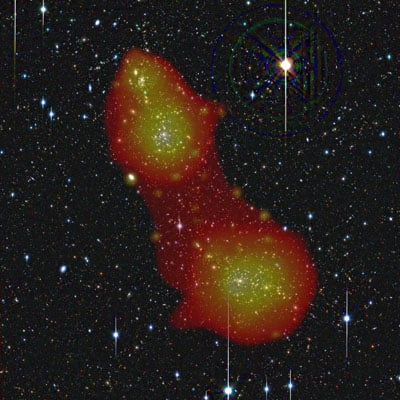We're getting the numbers down pretty well now about how much we
don't
know about the universe: Only about 5% of our universe consists of normal matter, made of atoms. The rest of our universe is composed of elusive matter that we don't understand: dark matter (23%) and dark energy (72%). And of that 5% of normal matter, well, we don't know what half of that is, either. All the stars, galaxies and gas observable in the universe account for less than a half of all the matter that should be around.
About 10 years ago, scientists predicted that the missing half of ‘ordinary’ or normal matter exists in the form of low-density gas, filling vast spaces between galaxies. The European Space Agency announced today that the orbiting X-ray observatory XMM-Newton has uncovered this low density, but high temperature gas.
The universe has been described as a cosmic web. The dense part of the web is made of clusters of galaxies, which are the largest objects in the universe. Astronomers suspected that low-density gas filled in the filaments of the web. But the low density of the gas has made it difficult to detect. With the XMM-Newton’s high sensitivity, astronomers have discovered the hottest parts of this gas.
Astronomers using XMM-Newton were observing a pair of galaxy clusters, Abell 222 and Abell 223, located 230 million light-years from Earth, when the images and spectra of the system revealed a bridge of hot gas connecting the clusters.
"The hot gas that we see in this bridge or filament is probably the hottest and densest part of the diffuse gas in the cosmic web, believed to constitute about half the baryonic matter in the universe," says Norbert Werner from SRON Netherlands Institute for Space Research, leader of the team reporting the discovery.
The discovery of this hot gas will help better understand the evolution of the cosmic web.
"This is only the beginning," said Werner. "To understand the distribution of the matter within the cosmic web, we have to see more systems like this one. And ultimately launch a dedicated space observatory to observe the cosmic web with a much higher sensitivity than possible with current missions. Our result allows to set up reliable requirements for those new missions."
Original News Source:
ESA Press Release
 Universe Today
Universe Today
